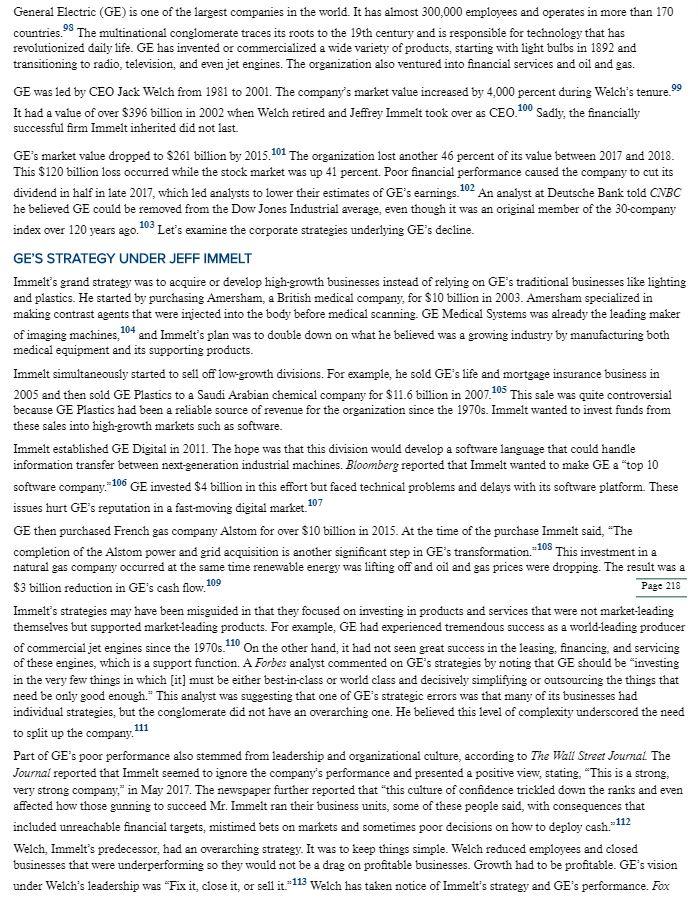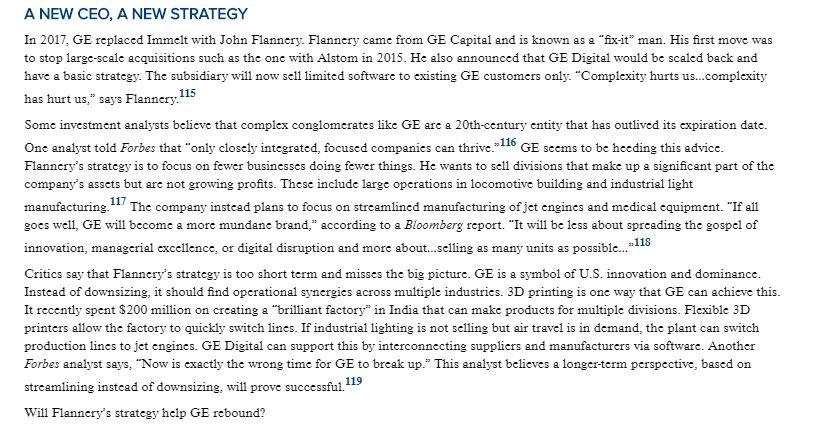Answered step by step
Verified Expert Solution
Question
1 Approved Answer
General Electric (GE) is one of the largest companies in the world. It has almost 300,000 employees and operates in more than 170 countries.



General Electric (GE) is one of the largest companies in the world. It has almost 300,000 employees and operates in more than 170 countries. The multinational conglomerate traces its roots to the 19th century and is responsible for technology that has revolutionized daily life. GE has invented or commercialized a wide variety of products, starting with light bulbs in 1892 and transitioning to radio, television, and even jet engines. The organization also ventured into financial services and oil and gas. 99 GE was led by CEO Jack Welch from 1981 to 2001. The company's market value increased by 4,000 percent during Welch's tenure. It had a value of over $396 billion in 2002 when Welch retired and Jeffrey Immelt took over as CEO 100 Sadly, the financially successful firm Immelt inherited did not last. GE's market value dropped to $261 billion by 2015.101 The organization lost another 46 percent of its value between 2017 and 2018. This $120 billion loss occurred while the stock market was up 41 percent. Poor financial performance caused the company to cut its dividend in half in late 2017, which led analysts to lower their estimates of GE's earnings. 102 An analyst at Deutsche Bank told CNBC he believed GE could be removed from the Dow Jones Industrial average, even though it was an original member of the 30-company index over 120 years ago. Let's examine the corporate strategies underlying GE's decline. 103. GE'S STRATEGY UNDER JEFF IMMELT Immelt's grand strategy was to acquire or develop high-growth businesses instead of relying on GE's traditional businesses like lighting and plastics. He started by purchasing Amersham, a British medical company, for $10 billion in 2003. Amersham specialized in making contrast agents that were injected into the body before medical scanning. GE Medical Systems was already the leading maker of imaging machines, 104 and Immelt's plan was to double down on what he believed was a growing industry by manufacturing both medical equipment and its supporting products. Immelt simultaneously started to sell off low-growth divisions. For example, he sold GE's life and mortgage insurance business in 2005 and then sold GE Plastics to a Saudi Arabian chemical company for $11.6 billion in 2007.105 This sale was quite controversial because GE Plastics had been a reliable source of revenue for the organization since the 1970s. Immelt wanted to invest funds from these sales into high-growth markets such as software. Immelt established GE Digital in 2011. The hope was that this division would develop a software language that could handle information transfer between next-generation industrial machines. Bloomberg reported that Immelt wanted to make GE a "top 10 software company." 106 GE invested $4 billion in this effort but faced technical problems and delays with its software platform. These issues hurt GE's reputation in a fast-moving digital market. 107 GE then purchased French gas company Alstom for over $10 billion in 2015. At the time of the purchase Immelt said, "The completion of the Alstom power and grid acquisition is another significant step in GE's transformation. 108 This investment in a natural gas company occurred at the same time renewable energy was lifting off and oil and gas prices were dropping. The result was a $3 billion reduction in GE's cash flow 109 Page 218 Immelt's strategies may have been misguided in that they focused on investing in products and services that were not market-leading themselves but supported market-leading products. For example, GE had experienced tremendous success as a world-leading producer of commercial jet engines since the 1970s.110 On the other hand, it had not seen great success in the leasing, financing, and servicing of these engines, which is a support function. A Forbes analyst commented on GE's strategies by noting that GE should be "investing in the very few things in which [it] must be either best-in-class or world class and decisively simplifying or outsourcing the things that need be only good enough." This analyst was suggesting that one of GE's strategic errors was that many of its businesses had individual strategies, but the conglomerate did not have an overarching one. He believed this level of complexity underscored the need to split up the company. 111 Part of GE's poor performance also stemmed from leadership and organizational culture, according to The Wall Street Journal The Journal reported that Immelt seemed to ignore the company's performance and presented a positive view, stating. "This is a strong, very strong company," in May 2017. The newspaper further reported that "this culture of confidence trickled down the ranks and even affected how those gunning to succeed Mr. Immelt ran their business units, some of these people said, with consequences that included unreachable financial targets, mistimed bets on markets and sometimes poor decisions on how to deploy cash.-112 Welch, Immelt's decessor, had an overarching strategy. It was to keep things simple. Welch reduced employees and closed businesses that were underperforming so they would not be a drag on profitable businesses. Growth had to be profitable. GE's vision under Welch's leadership was "Fix it, close it, or sell it.*113 Welch has taken notice of Immelt's strategy and GE's performance. Fox A NEW CEO, A NEW STRATEGY In 2017, GE replaced Immelt with John Flannery. Flannery came from GE Capital and is known as a "fix-it" man. His first move was to stop large-scale acquisitions such as the one with Alstom in 2015. He also announced that GE Digital would be scaled back and have a basic strategy. The subsidiary will now sell limited software to existing GE customers only. "Complexity hurts us...complexity has hurt us," says Flannery. 115 Some investment analysts believe that complex conglomerates like GE are a 20th-century entity that has outlived its expiration date. One analyst told Forbes that "only closely integrated, focused companies can thrive. 116 GE seems to be heading this advice. Flannery's strategy is to focus on fewer businesses doing fewer things. He wants to sell divisions that make up a significant part of the company's assets but are not growing profits. These include large operations in locomotive building and industrial light 117 manufacturing. The company instead plans to focus on streamlined manufacturing of jet engines and medical equipment. "If all goes well, GE will become a more mundane brand," according to a Bloomberg report. "It will be less about spreading the gospel of innovation, managerial excellence, or digital disruption and more about...selling as many units as possible..." 118 Critics say that Flannery's strategy is too short term and misses the big picture. GE is a symbol of U.S. innovation and dominance. Instead of downsizing, it should find operational synergies across multiple industries. 3D printing is one way that GE can achieve this. It recently spent $200 million on creating a "brilliant factory" in India that can make products for multiple divisions. Flexible 3D printers allow the factory to quickly switch lines. If industrial lighting is not selling but air travel is in demand, the plant can switch production lines to jet engines. GE Digital can support this by interconnecting suppliers and manufacturers via software. Another Forbes analyst says, "Now is exactly the wrong time for GE to break up." This analyst believes a longer-term perspective, based on 119 streamlining instead of downsizing, will prove successful. Will Flannery's strategy help GE rebound? 1. Explain how GE is creating a "fit" among its activities at its factory in India. 2. Using the steps 3. Develop a SWOT analysis for GE. 4. Is CEO Flannery employing a growth, stability, or defensive strategy? Is this different than Immelt's strategy? Explain. 5. Which of Michael Porter's four competitive strategies is GE trying to follow? Explain. describe how GE should be transforming the way it does business.
Step by Step Solution
★★★★★
3.51 Rating (164 Votes )
There are 3 Steps involved in it
Step: 1
1 Explain how GE is creating a fit among its activities at its factory in India Through their 3D pri...
Get Instant Access to Expert-Tailored Solutions
See step-by-step solutions with expert insights and AI powered tools for academic success
Step: 2

Step: 3

Ace Your Homework with AI
Get the answers you need in no time with our AI-driven, step-by-step assistance
Get Started


